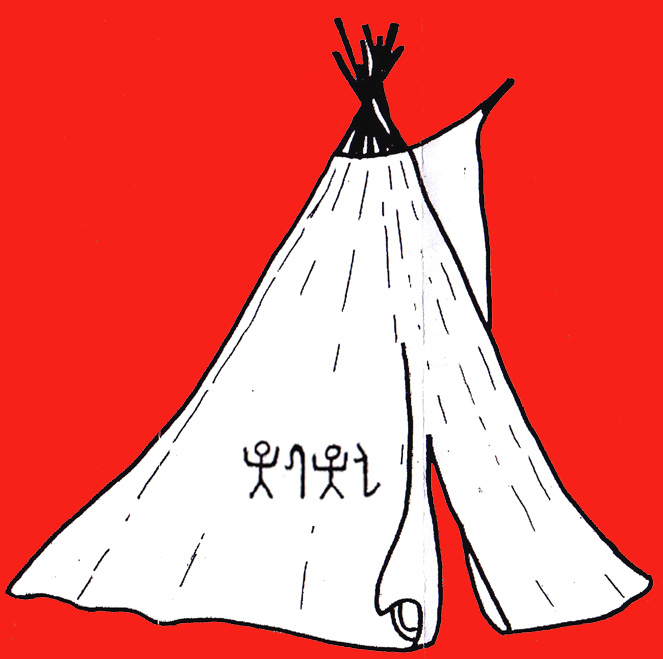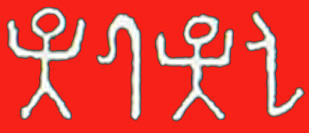
THE LATCHSTRING PICTURE

 |
THE LATCHSTRING PICTURE |
 |
| by
Berthalee Broyles
"The latchstring picture" is one of the famous murals in the state Capital at Harrisburg, Pennsylvania, done by Violet Oakley to commemorate scenes in Pennsylvania history. It stands as a unique record of security in the midst of terrible danger. Its story is one of sublime courage and literal faith. It is a true story; the brave young parents shown in the picture actually were Pennsylvania pioneers, and their experience was not an exceptional one in the times in which they lived. John and Mary lived beyond the settlements, in the depths of the dark forest. They were members of a peculiar religion known as "Friends," and they took its teaching literally. Accordingly, they turned no one from their door who came seeking shelter; and at night, when they lay down in the lonely darkness, they left the latchstring--the leather thong that raised the doorlatch--hanging outside, so that anyone could raise the latch and walk into the cabin. (Elohim) would protect them, they said. But one day a messenger came to warn them that, not far away, Indians were painting their faces. This meant a raid on the white settlers. John and Mary had better flee, he said. No, they replied, they could not do that. The messenger offered to divide his weapons with them, but that, they said, was against their religion. "At least," urged the messenger as he hurried on his way, "tonight, for the sake of your little children, pull in this latchstring when you go to bed, so that the Indians can not walk right in while you are asleep." As the messenger was lost to sight among the trees, the young pioneers looked at each other, and thoughts of Indian tortures for themselves and for their children laid cold fingers upon their hearts. It might be best, they agreed, to bar the door this one night. Evening fell and the lonely cabin was covered with the deep darkness of the woods. The children went to their beds in the loft; the parents, after their usual devotions, pulled in the latchstring and lay down in the bed by the fireplace. But, behind the barred door, they could not sleep. Tender consciences, accustomed to follow the word for word the teachings of their faith, would not let them rest. Finally, they talked together about the danger. "There keeps coming through my mind," said John, "the text, 'The arm of (YAHUWAH) is not shortened, that it cannot save!' " The decision was made; he unbarred the door. Once more the leather string hung as usual on the outside of the door, inviting any one who came to raise the latch and step inside the house. Sleep fell then upon the humble home, but, just before dawn, a slight sound broke the silence. Opening their eyes as they lay facing the door, the parents saw, by the faint firelight, the wooden bar across the door slowly rise. Someone was outside; someone was stealthily, gently pulling down on the latch that raised the bar. As they watched with wildly beating hearts, the door swung back. There, in the doorway stood a group of painted Indians, armed with scalping knife and tomahawk. It is this dreadful moment that the artist has chosen for the latchstring picture. Painted on the wall of the Senate Chamber of the state of Pennsylvania, two centuries later, are seen the pale and trembling parents, the hideous savages. One feels the terror of the moment, the very suspension of heartbeats, so that in that dreadful silence one may fancy the light breathing of the sleeping children overhead. But there is also a great angel with wings of defense outstretched above the words, "He shall give His angels charge concerning thee." What was the outcome of this desperate situation? Years afterward, an Indian captive told the story. The Indians that night destroyed every other white family's home in the valley, but finding the silent invitation of the latchstring, they spared that home. What turned them back from the unarmed pioneers, so that they crept silently away? Was there indeed a great angel with outstretched wings covering the defenseless heads of the humble (Messiahans)? What was the answer to the mystery? Never in all the history of Colonial Pennsylvania were settlers like John and Mary molested by the Indians. It was settled Indian practice to let them live; and such (Messiahans) could settle a day's journey farther into the forest than others dared to do. Why was this? It was not mere defenselessness; pacifism is not passivism. Back of the unbarred doors lay a long story of (Messianic) fellowship. At homes where the latchstring hung undrawn, Indians knew they would be received as brothers. In those cabins, tired and hungry Indians were sure of rest and food. When they traded with these pioneers, they were not cheated. They wanted these cabins left standing. The undrawn latchstring was not merely an emblem of (Messianic) courage; it was in that time and place a token of (Messiahan) practice. "These are Friends," said the Indians. "Let them live; we may come this way again, and we shall need these Friends." John and Mary had no wish to die a terrible death, but they feared even more that they might do wrong. On that dreadful night all others in the valley, seeking to save their lives, were lost. John and Mary, seeking first the Kingdom, were left alive. Their story has been chosen to appear in the Capitol of the state they helped to found, as an amazing testimony--the story of the latchstring.
|